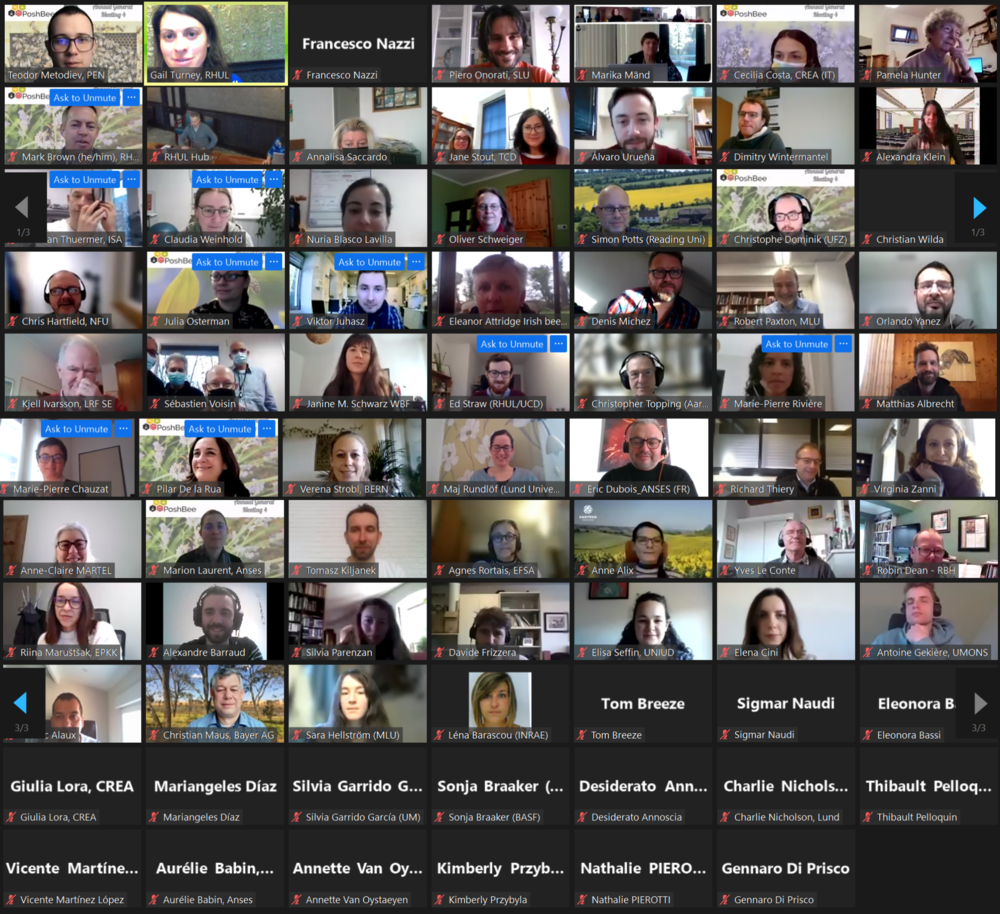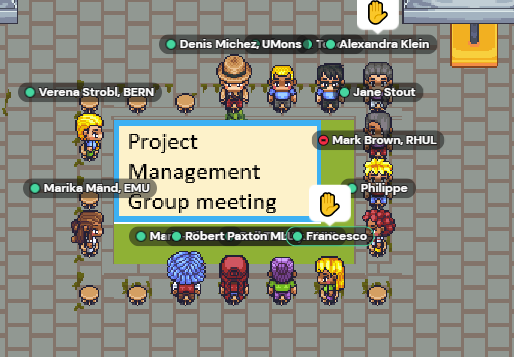pan-european assessment, monitoring, and mitigation of stressors on the health of bees
PoshBee’s Fourth Annual General Meeting
Consortium members, practitioners and other stakeholders of the PoshBee project met up between 11 and 13 January 2022 for the project’s fourth annual general meeting. The three-day-long event hosted by the coordinating institution Royal Holloway, University of London was marked by insightful presentations, vivid discussions and an overview of the project’s developments and future initiatives. The initial format in mind of the meeting was a hybrid conference environment, with five different ‘hublets’ (physical groups) organised in different European cities. Due to the emerging Omicron variant and the changing country regulations, only the UK and Estonia hubs took place, and the remaining participants attended the meeting online.

Group photo from PoshBee's Fourth Annual General Meeting.
The progress, challenges and future plans of all PoshBee work packages have been presented and discussed during the event. Starting of with a warm welcome by project coordinator Prof. Mark Brown and an overview of the financial and administrative aspects of the project, the first day of the meeting delivered important results and progress developments, as well as timelines for future plans, focusing on:
-
Agrochemical-pathogen interactions in different bees (Apis, Bombus & Osmia): a recent PoshBee experiment Investigated possible interactions between pesticides and varroa mite on honeybee health. The preliminary conclusions of the study will be finalised & published as a paper.
-
Chemical exposure, pathogens and aspects of nutrition: the development of air samplers to assess bees chemical exposure in hives is among the key tasks of this work package. Nearly 90 samples were collected and sent to beekeepers across the EU; they were replaced every 2 weeks and returned to University of Bourdeaux for analysis, which is currently ongoing. Moreover, an overview of the PoshBee DataBase (PoshBase) has been presented. The platform allows a centralized access to a significant amount of research data. Poshbase data is provided in formatted files which are easily extracted and foster the facilitation of joint statistical analyses to compare all the data.
-
Agrochemical-nutrition interactions on bee health in the lab: a variety of interesting experiments and their designs were presented, focusing on the topics of impacts of nutrition on bumblebee sensibility to pesticides; influence of sulfoxaflor and azoxystrobin on Osmia bicornis - nutritional intake, foraging behaviour and learning; impacts of pesticides on bumble bee nutritional intake, as well as differences in pesticide sensitivity between behavioural worker castes in Apis mellifera.
-
Knowledge Exchange and Impact Strategy: the key question of how we can bring the huge volume of quality outputs resulting from PoshBee to their end users has been discussed. University of Reading has the task of using the 'research engine' (publications, tools, reports, protocols) and moving it towards a real impact - changes in policy, decision-making, knowledge and behavior.
After a good night's rest, day two of the PoshBee AGM 2022 covered the following topics:
-
OMICS of agrochemical responses in bees: in a recent research paper, PoshBee partners from CNRS and BioPark Archamps report the use of MALDI imaging mass spectrometry to follow the molecular impact of an experimental infection of Apis mellifera with the microsporidia Nosema ceranae - you can read more here.
-
A site network for assessing exposure of bees to chemical/nutritional/pathogen stressors: although most of the work in this task is already complete, two new studies have been presented (Impact of landscape composition and configuration on flower-visiting insects communities across Europe & A study on apple landscapes)
-
Chemicals with other stressors in semi-field & field experiments: In 2019, PoshBee partners from University of Freiburg conducted semi-field experiments with Apis mellifera, Bombus terrestris & Osmia bicornis, with the same stressors (amistar & closer) - their results were published here and here. In 2020, the same experiment was scheduled with nutrition & amistar for Bombus terrestris in Germany and for Osmia bicornis in Switzerland. Due to COVID-19, the experiment was postponed to 2021 - it was then successfully carried out, and the data is now being analysed.
-
Dissemination, communication and knowledge transfer: Following an overview of the recent communication developments, the session focused on the aspect of exploitation. Exploitation of project results is among the key aspects for the successful implementation of any EU funded project. As PoshBee is already in an advanced stage, it is important to start exploring the different exploitation pathways for PoshBee Key Exploitable Results (KERs). This session primarily focused on one exploitation tool provided by the EC, the Horizon Results Platform, but also briefly outlined other exploitation pathways (Horizon Results Booster, Research Ideas and Outcomes Journal etc.).
-
Development of novel wild bee species for risk assessment: the goal of this work package is to develop new, representative, model wild bee species for scientific research. A recent soil contamination experiment featuring Anthophora plumipes has been conducted, and its results are now being finalsied.
-
Systems & agent-based modelling approaches to assess synergistic effects of multiple stressors on health: this session discussed the new agent-based risk assessment model for Bombus, the first version of which has been recently developed. The aim of the model is to evaluate management impacts with the focus on creating the basis for the risk assessment tools.
-
Toxicokinetics, toxicodynamics and interactions among agrochemicals: this session presented various studies and preliminary results. One prominent study led by INRAE focused on the long-term effect: the case of sulfoxaflor in honeybees, which showed that sulfoxaflor effects were delayed and emerged when bees transitioned to foraging activity. You can read more here.
The third and final day of the AGM consisted of breakout group meetings. These meetings focused on the different tasks of the project and discussed their next steps, potential risk mitigations etc. The breakout group meetings took place in GatherTown - a proximity video chat in fully customizable, 2D interactive spaces, with a dedicated space for PoshBee. The space allowed for group discussions, but also for informal one to one conversations, which are a key aspect of any meeting. After a successful Annual Assembly, PoshBee partners continue pursuing the mission to support healthy bee populations and sustainable pollination across Europe!

GatherTown Project Management Meeting.